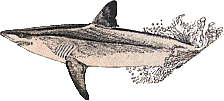 JASON VII
JASON VII
April Expedition
Shark Science Team
- Bob Hueter (host researcher)
- Charles Manire (biologist)
- Randy Edwards (tracking)
- Dick Hugus and Larry Ivey (Speaker technicians)
- NR-1 EATS team: Jon Howland (imaging), Dana Yoerger (navigation), Paul Donaldson (ROV pilot), Ivar Babb (ROV director), Greg Beers (pilot), Nick Worobey (ROV engineer)
- Student and Teacher Argonauts: Week One: Sylvia Pakstis, William LaCruz, Daniela Romero, Michelle You, Justin Desrosiers; Week Two: Alan Rodger, Betsy Berg, Kathi Jo Jankowski, Debra Montaya, Ryan Piwowarski, Lynn Cleckner
Locations/Science:
- Wreck site off of the SSV Carolyn Chouest
Smell/taste versus sound will be tested at the wreck site. Low frequency irregular pulsing sound (40-600 Hz) will be broadcast via an amplifier/underwater speaker system. This sound represents the distress of large prey. To test the senses of smell & taste, frozen chum (fish parts and blood) will be lowered into position.
The key questions that will be demonstrated are:
- What species are attracted to smell and which ones are attracted to sound?
- Which sense is dominant—can we move a feeding animal up to the speakers from the chum?
- What are the different jaw mechanisms involved in feeding on the chum?
- Humps
NR-1 would record images (stills/video) of sharks in the “humps” area. Depth and position as well as species data would be recorded.
The key questions are:
- What species of large sharks are present?
- Tracking Boat
Sharks will be caught using line and rod. The species, approximate size and sex will be determined and then the animals will be tagged with a transmitter. Two hydrophones are placed on boat which relay the position and depth of the shark every 10 minutes. These measurements will be relayed via VHF radio to the SSV Carolyn Chouest. The location of the tracking boat is known via a GPS (geographical positioning system) system so the location of the shark is calculated relative to the tracking boat. Temperature data is recorded via XBT’s (bathymetric temperature probes). A map showing the movement of the shark will be produced on the SSV Carolyn Chouest with the data.
The key questions are:
- What species of sharks are there?
- Do they move randomly or are they returning to a particular place?
- Are they blue water or inshore sharks?
- Does the same shark appear again?
- Mote Marine Laboratory, Sarasota, Florida (March 25/95)
Visual stimuli versus sound stimuli (40-600 Hz) were tested in a dumb-bell shaped tank at Mote Marine Laboratory (on sand and nurse sharks). The half dozen visual targets tested were selected from 50 targets built by JASON students. A combination of observations including species of shark attracted, length of time, hits etc. was collected and will be available online, along with images of all the shark targets received.
 Back to April Expedition Journal
Back to April Expedition Journal


JASON Project homepage ||
Teachers' Guide ||
Students' Corner ||
Search
Gene Carl Feldman (gene@seawifs.gsfc.nasa.gov)
(301) 286-9428
Todd Carlo Viola, JASON Foundation for Education (todd@jason.org)
Revised: 31 March 1996
![]() Back to April Expedition Journal
Back to April Expedition Journal
![]()
![]()